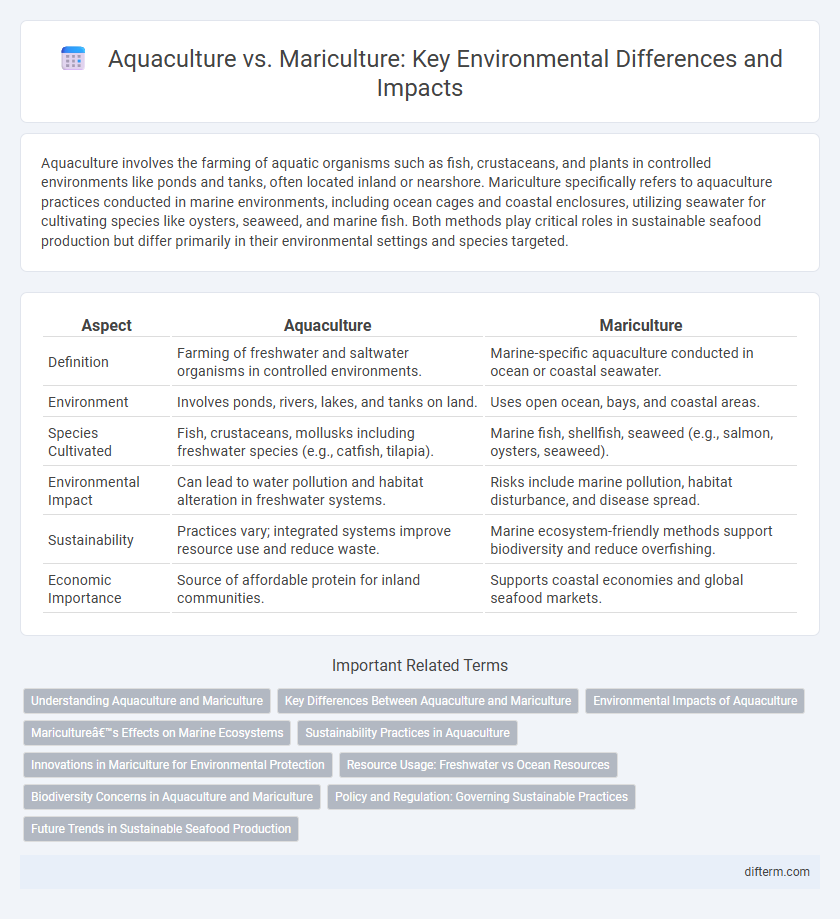Aquaculture involves the farming of aquatic organisms such as fish, crustaceans, and plants in controlled environments like ponds and tanks, often located inland or nearshore. Mariculture specifically refers to aquaculture practices conducted in marine environments, including ocean cages and coastal enclosures, utilizing seawater for cultivating species like oysters, seaweed, and marine fish. Both methods play critical roles in sustainable seafood production but differ primarily in their environmental settings and species targeted.
Table of Comparison
| Aspect | Aquaculture | Mariculture |
|---|---|---|
| Definition | Farming of freshwater and saltwater organisms in controlled environments. | Marine-specific aquaculture conducted in ocean or coastal seawater. |
| Environment | Involves ponds, rivers, lakes, and tanks on land. | Uses open ocean, bays, and coastal areas. |
| Species Cultivated | Fish, crustaceans, mollusks including freshwater species (e.g., catfish, tilapia). | Marine fish, shellfish, seaweed (e.g., salmon, oysters, seaweed). |
| Environmental Impact | Can lead to water pollution and habitat alteration in freshwater systems. | Risks include marine pollution, habitat disturbance, and disease spread. |
| Sustainability | Practices vary; integrated systems improve resource use and reduce waste. | Marine ecosystem-friendly methods support biodiversity and reduce overfishing. |
| Economic Importance | Source of affordable protein for inland communities. | Supports coastal economies and global seafood markets. |
Understanding Aquaculture and Mariculture
Aquaculture involves the breeding, rearing, and harvesting of aquatic organisms such as fish, shellfish, and plants in controlled freshwater or saltwater environments, enhancing food security and reducing pressure on wild fisheries. Mariculture specifically refers to aquaculture practices conducted in marine settings, including oceans and coastal areas, utilizing techniques like open-net pens, raceways, and seaweed farming. Understanding the distinctions and applications of aquaculture and mariculture is essential for sustainable seafood production and ecosystem management.
Key Differences Between Aquaculture and Mariculture
Aquaculture encompasses the controlled cultivation of both freshwater and marine organisms, whereas mariculture specifically refers to the farming of marine species in saltwater environments. Key differences include the habitat type, with aquaculture occurring in freshwater ponds, tanks, or rivers, and mariculture utilizing open ocean sites, coastal areas, or enclosed sections of the marine environment. Moreover, mariculture often faces unique challenges such as saltwater corrosion and marine predators, distinct from those typically encountered in freshwater aquaculture.
Environmental Impacts of Aquaculture
Aquaculture, the farming of freshwater species, often leads to nutrient pollution and habitat destruction, impacting surrounding ecosystems adversely. Mariculture, a subset of aquaculture in marine environments, can cause localized water quality degradation due to waste accumulation and escape of farmed species. Both practices require sustainable management to mitigate effects like eutrophication, disease spread, and biodiversity loss in aquatic habitats.
Mariculture’s Effects on Marine Ecosystems
Mariculture, the cultivation of marine organisms in ocean environments, can significantly impact marine ecosystems by altering local water quality through nutrient runoff and chemical use, leading to eutrophication and habitat degradation. This farming method often disrupts natural species interactions and biodiversity by introducing non-native species and concentrating diseases. Effective management practices are essential to mitigate these environmental impacts and ensure the sustainability of marine resources.
Sustainability Practices in Aquaculture
Sustainability practices in aquaculture prioritize reducing environmental impacts through efficient resource management, use of native species, and minimizing chemical inputs to protect surrounding ecosystems. Innovations such as integrated multi-trophic aquaculture (IMTA) enhance nutrient recycling by combining species at different trophic levels, improving overall system health and productivity. Adopting eco-friendly feed alternatives and closed-loop water systems further promotes sustainability by lowering pollution and conserving water resources.
Innovations in Mariculture for Environmental Protection
Innovations in mariculture focus on sustainable practices such as integrated multi-trophic aquaculture (IMTA), which simultaneously cultivates fish, shellfish, and seaweed to enhance nutrient recycling and reduce environmental impact. Advanced recirculating aquaculture systems (RAS) in mariculture improve water quality management and minimize waste discharge, promoting healthier marine ecosystems. Genetic improvements and selective breeding further optimize species resilience and growth rates, reducing resource use and supporting long-term environmental protection.
Resource Usage: Freshwater vs Ocean Resources
Aquaculture primarily relies on freshwater resources, often necessitating significant water withdrawal from rivers and lakes, which can strain local ecosystems. Mariculture utilizes ocean resources, leveraging the vast saline environment to cultivate marine species with minimal freshwater consumption. Efficient management of these resources is critical to reducing environmental impact and ensuring sustainable seafood production.
Biodiversity Concerns in Aquaculture and Mariculture
Aquaculture and mariculture pose significant biodiversity concerns due to habitat alteration, pollution, and the risk of invasive species introduction, which can disrupt local ecosystems and native species populations. Intensive fish farming practices often lead to nutrient loading and chemical use, causing eutrophication and degradation of surrounding aquatic environments. Protecting biodiversity requires sustainable management protocols that minimize environmental impacts and preserve genetic diversity within marine and freshwater habitats.
Policy and Regulation: Governing Sustainable Practices
Aquaculture and mariculture policies emphasize sustainable resource management, incorporating strict regulations on water quality, habitat protection, and species selection to mitigate environmental impacts. Regulatory frameworks often include licensing requirements, monitoring programs, and enforcement mechanisms to ensure compliance with best practices and reduce pollution, disease spread, and biodiversity loss. International treaties, national laws, and regional guidelines collectively shape governance structures promoting eco-friendly aquaculture and mariculture development.
Future Trends in Sustainable Seafood Production
Aquaculture and mariculture are rapidly evolving with innovations focused on sustainable seafood production, emphasizing eco-friendly feed, disease management, and habitat restoration. Advances in offshore mariculture systems and integrated multi-trophic aquaculture (IMTA) promote higher biodiversity and reduce environmental impacts. Future trends prioritize enhancing production efficiency while minimizing carbon footprints and preserving marine ecosystems.
aquaculture vs mariculture Infographic

 difterm.com
difterm.com